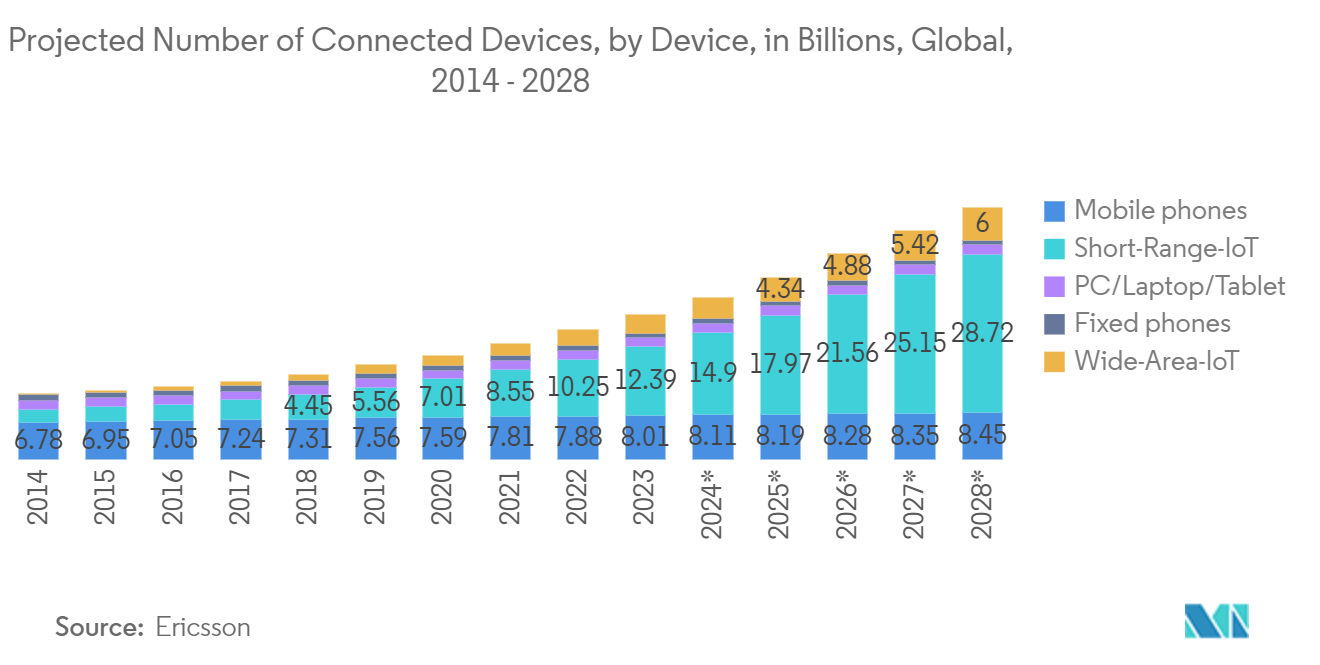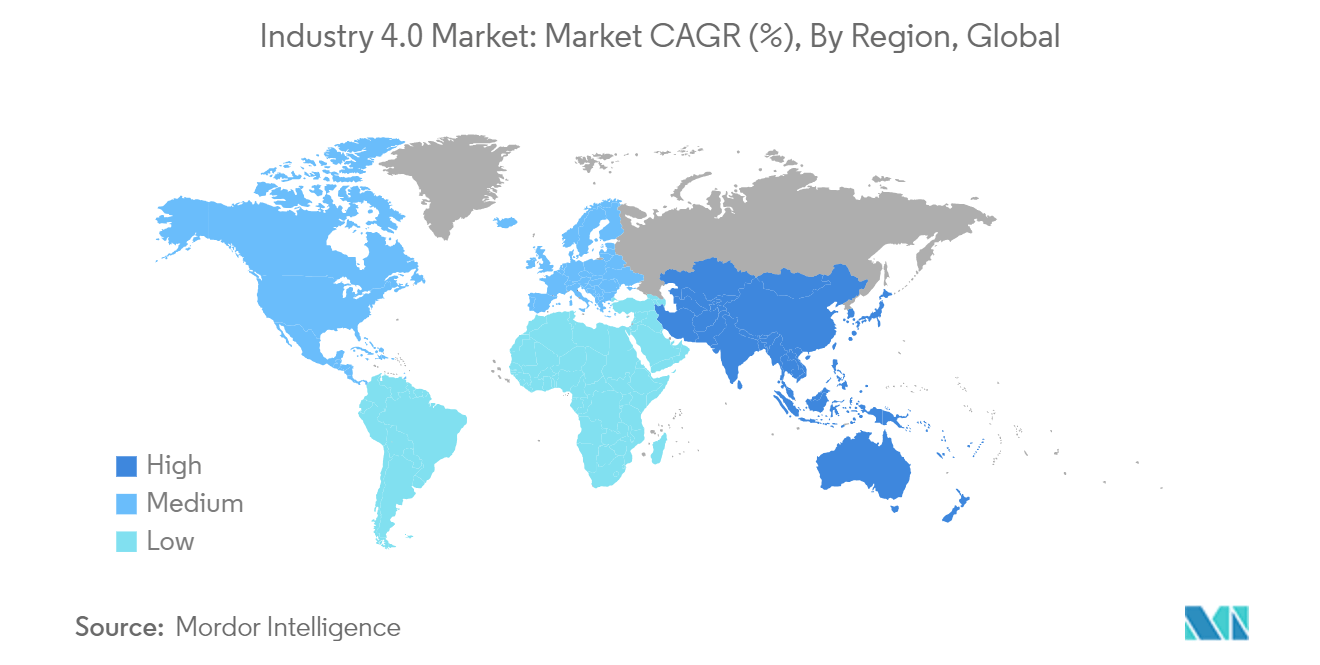Market Trends of Industry 4.0 Industry
IIoT Technology Segment Holds Significant Market Share
- As a cornerstone of Industry 4.0, the Internet of Things (IoT) plays a pivotal role in monitoring production systems across both manufacturing and service sectors. By harnessing IoT, manufacturers can unlock innovative avenues, driving enhanced performance. At its core, IoT excels in gathering and disseminating data via internet-connected machines and devices. Each device is tagged with a unique identification number or code, allowing control through everyday gadgets like smartphones.
- Key components of this technology encompass software and hardware, all interconnected through a network for data collection and alteration. IoT is not just a tool; it is a catalyst for disruptive innovation in manufacturing. Recognizing the potential of IoT is essential for modern production systems. Within the realm of Industry 4.0, IoT stands out as a significant leap forward, enabling comprehensive smart monitoring of manufacturing processes.
- IIoT technologies play a pivotal role in driving Industry 4.0 initiatives, showcasing their impact in various forms. A dominant manifestation is the smart factory approach, where sensors and interconnected monitoring/analysis devices exchange data, enabling real-time enhancements. This seamless communication is bolstered by the swift adoption of 5G networks, ensuring rapid data transfer and fortified by robust cybersecurity measures to safeguard these connections.
- The growing adoption of industrial IoT technology across manufacturing, automotive, and healthcare sectors is driving positive market expansion. As the traditional manufacturing sector undergoes a digital transformation, the IIoT is spearheading this evolution, heralding a new industrial revolution of intelligent connectivity. This transformation is reshaping how businesses manage their sophisticated systems and machinery, aiming to boost productivity and minimize downtime.
- At the heart of the logistics chain's development, production, and management, termed smart factory automation, lie Industry 4.0 and IIoT. As manufacturing undergoes seismic shifts due to Industry 4.0 and the embrace of IIoT, businesses are compelled to adopt agile, innovative methods. These methods not only enhance production through technologies that complement human labor with robotics but also aim to curtail industrial accidents stemming from process failures.
- The surge in connected devices, sensors, and M2M communication in the manufacturing sector has led to an explosion of generated data points. According to Ericsson, Between 2022 and 2028, the global count of connected devices is projected to nearly double. This surge is largely attributed to the rise of short-range IoT (Internet of Things) devices, with forecasts estimating 28.72 billion of these devices by 2028.
- These data points vary widely, from basic metrics like the time taken for materials to complete a process cycle to advanced calculations, such as assessing material stress capabilities in the automotive sector. IIoT is expected to be the solution to address the requirements of such use cases.

Asia Pacific to Register Significant Growth
- Years ago, India embarked on a vision to transform into a manufacturing and export powerhouse. This initiative aimed to reduce the nation's reliance on imports and elevate India's status as a global manufacturing leader, capable of producing goods for both domestic consumption and international markets.
- Campaigns such as 'Make In India' and 'Atmanirbhar Bharat' were introduced to bolster the manufacturing sector, targeting a GDP contribution of 25% by 2025, up from the current 16%. With advanced technology and a vast internal consumer base, India stands poised to produce globally competitive products in quality and price. Yet, to realize this potential, India requires more than just ambition; and it needs to embrace Industry 4.0. The advent of IoT in India, especially under the government's "Digital India" initiative, heralds this technological revolution.
- Globally, industries are witnessing the benefits of Industry 4.0, which promises to minimize defects and wastage in production. For India, this presents a timely opportunity to reshape its narrative, especially given the shifting global political landscape and the renewed interest from developed nations in diversifying away from their traditional manufacturing hubs.
- Amidst geopolitical shifts, technological lags, and competitive advantages, China's industries are in a state of transformation. With a clear trajectory toward Industry 4.0, China's manufacturing sector is set for rapid acceleration. As the world's largest manufacturing hub, China is at the helm of the digital revolution, harnessing its expansive industrial base and technological capabilities to spearhead innovation.
- The Chinese government, with initiatives like “Made in China 2025”, is championing the adoption of Industry 4.0 technologies, aiming to elevate manufacturing capabilities and nurture high-tech industries. Drawing inspiration from Germany’s Industry 4.0, "Made in China 2025" focuses on developing cloud-driven IoT and tailored industrial automation systems.
- In a bid to enhance their global footprint, Japanese robot and automation suppliers have not only increased their production capacities but have also established manufacturing sites overseas. For example, in July 2024, Fanuc's US subsidiary inaugurated a USD 110 million facility in Michigan. This facility is dedicated to storing, selling, and maintaining industrial robots, all manufactured in Japan, specifically catering to North American clientele.


